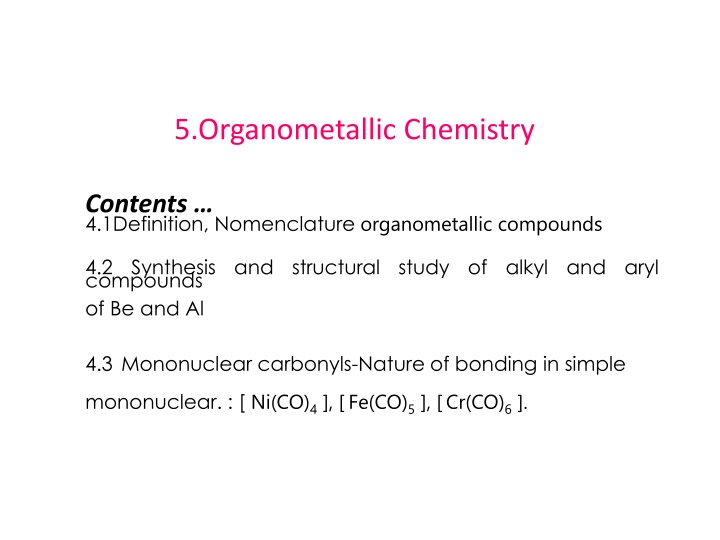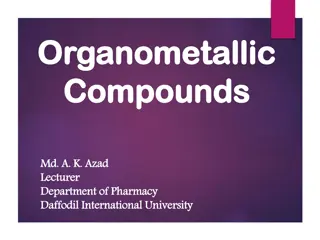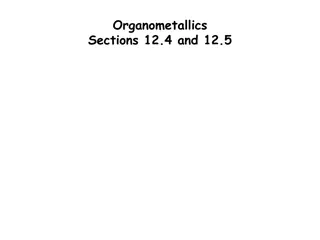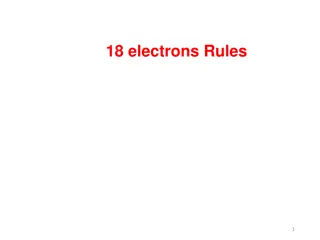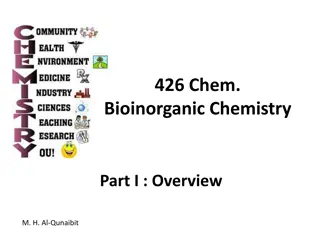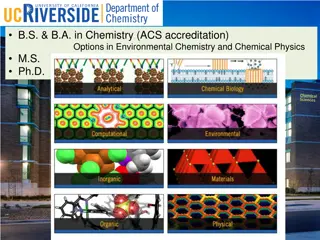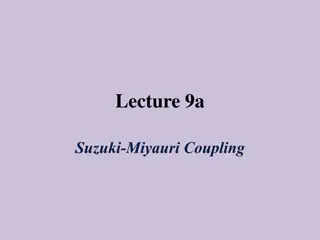5.Organometallic Chemistry
Organometallic compounds contain metal-carbon bonds and play a significant role in modern chemistry due to their unique properties. This text explores the definition, nomenclature, and synthesis of these compounds, highlighting their importance in various chemical reactions and applications.
Download Presentation

Please find below an Image/Link to download the presentation.
The content on the website is provided AS IS for your information and personal use only. It may not be sold, licensed, or shared on other websites without obtaining consent from the author.If you encounter any issues during the download, it is possible that the publisher has removed the file from their server.
You are allowed to download the files provided on this website for personal or commercial use, subject to the condition that they are used lawfully. All files are the property of their respective owners.
The content on the website is provided AS IS for your information and personal use only. It may not be sold, licensed, or shared on other websites without obtaining consent from the author.
E N D
Presentation Transcript
5.Organometallic Chemistry Contents 4.1Definition, Nomenclature organometallic compounds 4.2 Synthesis and structural study of alkyl and aryl compounds of Be and Al 4.3 Mononuclear carbonyls-Nature of bonding in simple mononuclear. : [ Ni(CO)4 ], [Fe(CO)5 ], [Cr(CO)6 ].
4.1 Definition, Nomenclature organometallic compounds : Definition: Organometallic compounds are defined as the compounds containing at least one metal carbon bond between metal and the carbon of an organic molecule, ion or a radical . The organometallic compounds consist of main group elements, lanthanons, actinons or borderline metals like Si, As, B, Te etc. bonded to one or more carbon atoms from an organic group by ionic or covalent bonds. The bond may be localized or delocalized. Classically, compounds having bonds between one or more metal atoms and one or more carbon atoms from organic group are termed as organometallic compounds. The chemistry of organometallics show many similarities to those of metal carbonyls (e.g. Ni(CO)4), cyanos (e.g. NaCN) and their derivatives. Metal carbonyls and cyano compounds are not considered as organometallic compounds since the carbon bonded to metal is not the part of a typical organic substrate. Generally M C bonds are weaker in strength as compared to M N, M O and M-halide bonds. Metals are more electropositive than carbon, so the carbon in organometallic compounds is negatively polarized and thus can act as nucleophile (in contrast to C N, C O bonds where carbon is positively polarized so acts as electrophile). The bond weakness is the bases for use of organometallic compounds in the synthesis. The reactivity of organometallic compounds depends on the electropositivity of the metal, therefore, for the compounds of the same group elements, the reactivity steadily decreases as we move down in the group (due to decrease in electropositive character).
Nomenclature: 1. Binary Type Nomenclature : This type of nomenclature is widely used to name salt like ionic species. The organometallics which have considerable ionic character are considered as the derivatives of inorganic salts or molecules. The derivatives of alkyls or aryls in which the substitution is not made within the hydrocarbon group are named by this system. The oxidation state of the metal may be indicated by using Roman numerals enclosed in parentheses after the name of the metal. For example : CH3MgBr : Methyl magnesium(II) bromide. C6H5HgOOCCH3 : Phenyl mercury(II) acetate. (CH3)3SnBr : Trimethyl tin(IV) bromide. If there is some substitution in the hydrocarbon group, the usual rules of organic nomenclature are followed to get the name of the hydrocarbon group and the name is written as stated earlier. e.g. (C6H2Cl3)2Hg : bis (trichlorophenyl) mercury. 2. Substitutive Nomenclature : . These compounds are named by first naming the organic group with proper ending followed by name of metal. The s and p block organometallics are named either as (i) derivatives of hydride or (ii) substituents in organic compounds. (i) As derivatives of hydride : The first system is based on the concept of a parent hydride e.g. SiH4 = silane, AsH3 = arsane etc. The organometallic compounds are considered as the derivatives of parent hydrides formed after partial or complete replacement of hydrogen by organic groups. For example : B(CH3)3 Trimethyl borane, Si(CH3)4 Tetramethyl silane, As(C2H5)3 Triethyl arsane, B(C6H11)2H Dicyclohexyl borane.
(ii) As substituents in organic compounds : The name of organometallic compounds is derived from organic group attached via a carbon atom. The bonding of such organic species to metal in organometallic compounds is usually highly covalent. The ending -e of the parent organic species is changed to -yl followed by the name of the metal without any gap. For normal chain the locant 1 is omitted while for branched chain the locant number including 1 must be cited. For example : CH3-CH2-CH2-CH2-CH2-Na : Pentanylsodium This method is recommended for naming covalent organometallic compounds containing saturated, acyclic and monocyclic hydrocarbon substituent groups. For example : BuLi : Butyl lithium CH3Li : Methyl lithium CH3Na : Methyl sodium CH3-CH2Li : Ethyl lithium CH2 = CHCH2Na : 2 Propenyl sodium CH2 = CHNa : Ethylene sodium (CH3)2CHCH2Li :1, 1-Dimethyl ethyl lithium (C6H5)2Mg : bis (phenyl) magnesium However, the common names of organic groups can also be used. For example : (CH3)2CHLi : Isopropyl lithium CH2 = CHCH2Na : Allyl sodium (CH3)3CLi : tert- Butyl lithium.
For example : 3. Co-ordination Nomenclature : For naming the organometallic compounds of d- and f-block elements, the usual rules for naming coordination compounds are followed. Organometallic compounds are thought to be produced by addition reactions and so they are named on an addition principle. The name therefore is built around the central metal atom according to the rules of the co-ordination chemistry. The organometallic compounds containing an organic ligand attached to metal via a single carbon atom as anion (formed by removing a hydrogen atom of an organic molecule) are named by replacing the final e of the parent compounds by ide. For example : CH3 methanide, C5H5 cyclopentadienide. Neutral and cationic names are used without further modification. This type of nomenclature is also used in naming highly covalent compounds of alkali and alkaline earth metals. In organometallic compounds to designate the points of attachment of ligands to metals, the , and notations are used. The number of carbon atoms within an organic species which are directly linked with the metal is specified by the prefix h (the Greek letter etc). This is called hapticity. If the ligands bond through one atom it is called monohapto. Some ligands for example benzene may bond to a metal centre through 1, 2 or 3 bonds. Consequently we can describe benzene as bi-, tetra- or hexa- hapto and use the notation h2, h4 and h6 since the bonding to be across two, four and six ligand atoms, respectively. For example (C6H6)2 Cr : bis h6 - benzene) chromium. Organic species which bridge two metal centres are indicated by the prefix m (the Greek letter mu). The Greek letter m appears before the name of ligand and separated by hyphen. If bridging ligand occurs more than once and multiplicative prefixes bi, tri etc. are used. ( -ethane-1, 1-diyl) bis (pentacarbonylrhenium) The points of ligation (attachment) of a polyatomic ligand to a co-ordination centre are indicated by an italic element symbol followed by a Greek Kappa, K, Metal-metal bonding may be indicated in names by italicized atomic symbols of the appropriate metal atoms separated by a long dash and enclosed in parentheses.
4.2 Synthesis and structural study of alkyl and aryl compounds of Be and Al : Introduction : Organometallic compounds of alkali metals have many structural and chemical similarities to hydrogen compounds. This is because of the fact that the electronegativity of M C bond is similar to C H and M H bonds. Organic species which readily lose protons usually form ionic compounds with alkali metals. For example, cyclopentadiene reacts with sodium metal; cyclopentadiene reacts with sodium metal to produce bis (cyclodienyl) sodium. Organolithium compounds are very important in organic synthesis. They act in a similar way to Grignard reagents but are much more reactive. They can do some transformations that Grignard s cannot (e.g. polymerization of alkenes). Lithium alkyls and aryls are liquids or low melting solids and are thermally more stable than other organometallic compounds of the same group .They are soluble in organic and non-polar solvents. All organometallic compounds of alkali metals are unstable and pyrophoric. They are available commercially as solutions. In alkaline earth metals the reactivity and electropositive nature increase as we move down in a group. Therefore the organometallic compounds of beryllium and magnesium form the most important covalent compounds, while rest of the group elements like calcium, strontium and barium form only few of the organometallic compounds which are generally ionic, very unstable and of little utility as compared to those of magnesium compounds. Organometallic compounds of smallest and most electropositive elements like Li, Be, Al etc. have a structural chemistry and reactivity, strongly influenced by the electron deficiency and by the presence of a number of valence bonds. Simple alkyls are simple sigma donors, which can be considered to donate one or two electrons to the metal centre. For simple metal alkyls the M C bond distance is typically 190 to 220 pm. This is approximately the sum of the covalent radii of carbon and metal, say rc = 77 pm and rM ~ 120 pm. However the first row transition metals are smaller in size, so any M C bond distance will usually be smaller by 10-20 pm or so. Alkyls can also bridge two metal centres.
1. Synthesis and Structural Study of Alkyl and Aryl Compounds of Beryllium: Synthesis: (i) Metathesis : Synthesis of organoberyllium compounds is carried out by halogen exchange or metathesis reaction in which a beryllium halide reacts with an organometallic compound of a different metal (e.g. lithium, sodium etc.). Be + HgR2 BeR2 + Hg (where R = CH3C6H5 group) ether e.g. BeCl2 + 2CH3Li (CH3)2Be + 2LiCl Dimethyl beryllium ether BeCl2 + 2MgCH3Cl (CH3)2Be + 2MgCl2 ether BeCl2 + 2C6H5Li (C6H5)2Be + 2LiCl (Diphenyl beryllium 3(C2H5)2Be + 2(C6H5)3B 2(C2H5)3B + 3(C6H5)2Be Diphenyl beryllium Bis (cyclopentadienyl) Be can be prepared by a double displacement reaction between BeCl2 with Na(C5H5). The anion (C5H5)is transferred to more electropositive Be(II) atom. BeCl2 + 2Na[C5H5] [C5H5]2Be + 2NaCl In this way reactions between halide and organo groups are effectively transferred between the two metals. Beryllium is less electropositive (or more electronegative) than Li, Na, Mg, so it forms organometallic compound while more electronegative metal forms halide. However, this synthetic route has one drawback that the product is always associated with ether molecules which cannot be separated easily.
(ii) Transmetallation from Mercury Alkyl or Aryl : Alkyl or aryl beryllium compounds can be prepared by transmetallation from methyl mercury. This method is employed to prepare ether free product. In this reaction, pure beryllium metal is heated with suitable mercury alkyl or aryl 110. Be + (CH3)2Hg (CH3)2Be + Hg Be + (C6H5)2Hg (C6H5)2Be + Hg The product can be collected by distillation in vacuum. The organometallic compounds of Be do not have significant commercial applications due to their high toxicity. They are used in laboratory as synthetic intermediates to produce other compounds of beryllium. Structural Study of Alkyl Beryllium : 1. Alkyl beryllium has insufficient electrons, so that the compounds are electron deficient. 2. Methyl beryllium (CH3)2Be is a monomer in the vapour phase. In solid state, it exists as a polymer. Bulkier alkyl groups attached to Be atom in organoberyllium compounds show lower degree of polymerization. 3. X-ray diffraction studies on (CH3)2Be indicated the presence of a long chain like polymeric structure having metals tetrahedrally co-ordinated by methyl groups. 4. The structure of (CH3)2Be is analogous to BeCl2. 5. The bonding in Be(CH3)2 is best described by 3c-2e bonds (analogous compound BeCl2 has 2c-2e bonding). 6. The 3c-3e bonding : In Be(CH3)2 both Be and C are sp3 hybridized. Be (4) : 1s2, 2s2
In Be, one s orbital (with one electron) and three p orbitals (with one electron hybridize to produce four sp3 hybrid orbitals containing two electrons). In this way only two hybrid orbitals contain unpaired electrons, while other two hybrid orbitals are empty. Carbon also forms four hybrid orbitals containing four unpaired electrons. There are two methyl bridging groups linking to two adjacent Be atoms by 3c-2e bonds. The overlap of one empty sp3 hybrid orbital of first Be, one sp3 hybrid orbital of carbon from methyl group containing one electron and sp3 hybrid orbital of another Be containing one electron give 3c 2e bonding. Similarly other 3c 2e bond results by overlap of one sp3 hybrid orbital of first Be containing one electron, one sp3 hybrid orbital of carbon from other methyl group containing one electron and an empty sp3 hybrid orbital of other Be. The bonding pair of electron is delocalized over three centres as shown in Fig. 5.1. Each C atom in Me2Be shows a co-ordination number five. Fig. 5.2 : Polymeric structure of M(Me)2, M = Be, Mg (a) 5.1 ,3c-2e bonding in Be(CH3)2 (b) Schematic view o (b) f bridging bonds Simple methyl beryllium is polymeric in nature. Refer Fig 5.2. However, higher alkyls are progressively less polymerized. For example, diethyl and isopropyl beryllium in benzene, while t- butyl beryllium is monomeric.
(CH3)3Al2Cl3 2. Synthesis and Structural Study of Alkyl and Aryl Compounds of Aluminium Compounds : Synthesis : Organo aluminium compounds are prepared by the following methods. (i) Transmetallation : Alkyl aluminium compounds can be prepared on a laboratory scale by transmetallation of a mercury compound. For example, 90 c 3R2Hg + 2Al 2R3Al + 3Hg (R is alkyl or aryl group) 90 c 3(Me)2Hg + 2Al Me6Al2 + 3Hg (ii) Reaction of alkyl with Al metal : Trimethyl aluminium is prepared commercially by the reaction of aluminium metal with chloromethane to give (CH3)4Al2Cl2. This is then reduced with sodium to give (CH3)6Al2. 2Al + 3CH3Cl Trace OF I2(AlCl3) (CH3)3Al2Cl3 (CH3)3Al2Cl3 disproportionate to (CH3)4Al2Cl2 and(CH3)2Al2Cl4. (CH3)3Al2Cl3 (CH3)4Al2Cl2 + (CH3)2Al2Cl4 Addition of NaCl in the mixture is carried out to remove (CH3)2Al2Cl4 as soluble Na[CH3AlCl3] complex so that (CH3)4Al2Cl2 can be separated by distillation. Finally (CH3)4Al2Cl2 reacts with Na to give (CH3)6Al2. 3(CH3)4Al2Cl2 + 6Na 2(CH3)6Al2 + 2Al + 6NaCl The commercial synthesis of triethyl aluminium and higher alkyl compounds is carried out from reaction of Al metal, an appropriate alkene and hydrogen gas at the temperature 110 C under pressure. The process is called hydroalumination. This route is relatively less expensive. Al + H2 + 3C2H4 (C2H5)3Al
(iii) From alkyl aluminium hydride : Aluminium hydride reacts with olefins to produce aluminium alkyls. AlH3 + 3CH2 = CH2 (CH2CH3)3Al The reaction is specific to boron and aluminium hydrides. Aluminium hydrides are made by reaction of Al, H2 and aluminium alkyls. Organoaluminium compounds are used as the Zeigler Natta catalyst for polymerisation of alkenes and for preparation of aluminium alkoxides and amides. Study of Alkyl Aluminium : 1. Trialkyls and aryls of aluminium are dimers having terminal and bridging methyl/aryl groups. They exist as dimers in solid as well as vapour phase. 2. Simple dimeric organoaluminium compounds are (Me3Al)2 and (ph3Al)2 while (phCH2)3Al is chain oligomer. 3. (Me3Al)2 is a dimeric solid (M.P 15 C) with methyl bridging involving three centered bonding (similar to aluminium chloride with methyl groups replacing Structural Cl atoms). In aluminium halides, the bridging Al Cl Al bonds are longer than the terminal Al C bonds, suggesting that they are 3-center 2-electron bonds (each Al Cl bond involves an electron pair). While in alkyl aluminium compounds the Al Cl Al bonds are longer than the terminal Al C bonds, suggesting that they are 3-center 2-electron bonds, with one bonding pair shared across the Al C Al somewhat analogous to the bonding in diborane B2H6. The terminal Al C bond is 195 pm while bridging bond is 212 pm. The Al C Al angle is approximately 75 for methyl in bridging, 90 when halide alkoxide amides are bridging, it increases bonding, involves sp3 hybrid orbital from two Al atoms and bridging alkyl carbon atoms.
The hybridization of both Al and C are sp3. Out of four hybrid orbitals, one is empty. The empty hybrid orbital of one Al, half filled hybrid orbital of other Al and half filled hybrid orbital of one methyl C overlap to produce one bridge bond involving three centers with only two electrons. Similarly second bridge is produced by overlap of one half filled hybrid orbital of first Al, empty hybrid orbital of other Al and half filled hybrid orbital of second methyl C. The 3c-2e bonding is shown in Fig. 5.3. Fig 5.3 : 3c-2e bond formed by symmetric combinations of Al and C orbitals 5. Triphenyl aluminium exists as a dimer with bridging phenyl groups lying in a plane perpendicular to the line joining the two aluminium atoms. This structure has less steric hindrance. The 3c-2e bonding is strengthened due to participation of phenyl pi- orbital. Triphenyl aluminium contains two bridging phenyl carbons. The phenyl bridge is oriented perpendicular to Al C Al C plane as shown in Fig. 5.5. Fig. 5.5 : Structure of triphenyl aluminium Fig. 5.4 : Structure of Me6Al2 6.Triphenyl aluminium exists as a dimer with bridging phenyl groups lying in a plane perpendicular to the line joining the two aluminium atoms. This structure has less steric hindrance. The 3c-2e bonding is strengthened due to participation of phenyl pi-orbital. Triphenyl aluminium contains two bridging phenyl carbons. The phenyl bridge is oriented perpendicular to Al C Al C plane as shown in Fig. 5.5.
2. Synthesis and Structural Study of Alkyl and Aryl Compounds of Aluminium Compounds Synthesis : Organo aluminium compounds are prepared by the following methods. (i) Transmetallation : Alkyl aluminium compounds can be prepared on a laboratory scale by transmetallation of a mercury compound. For example, 90 c 3R2Hg + 2Al 2R3Al + 3Hg (R is alkyl or aryl group) 90 c 3(Me)2Hg + 2Al Me6Al2 + 3Hg (ii) Reaction of alkyl with Al metal : Trimethyl aluminium is prepared commercially by the reaction of aluminium metal with chloromethane to give (CH3)4Al2Cl2. This is then reduced with sodium to give (CH3)6Al2. Trace of I2 2Al + 3CH3Cl ----- (CH3)3Al2Cl3 AlCl3 (CH3)3Al2Cl3 disproportionate to (CH3)4Al2Cl2 and(CH3)2Al2Cl4. (CH3)3Al2Cl3 Addition of NaCl in the mixture is carried out to remove (CH3)2Al2Cl4 as soluble Na[CH3AlCl3] complex so that (CH3)4Al2Cl2 can be separated by distillation. Finally (CH3)4Al2Cl2 reacts with Na to give (CH3)6Al2. 3(CH3)4Al2Cl2 + 6Na 2(CH3)6Al2 + 2Al + 6NaCl (CH3)4Al2Cl2 + (CH3)2Al2Cl4
(iii) From alkyl aluminium hydride : Aluminium hydride reacts with olefins to produce aluminium alkyls. AlH3 + 3CH2 = CH2 (CH2CH3)3Al The reaction is specific to boron and aluminium hydrides. Aluminium hydrides are made by reaction of Al, H2 and aluminium alkyls. Organoaluminium compounds are used as the Zeigler Natta catalyst for polymerisation of alkenes and for preparation of aluminium alkoxides and amides. Structural Study of Alkyl Aluminium : 1. Trialkyls and aryls of aluminium are dimers having terminal and bridging methyl/aryl groups. They exist as dimers in solid as well as vapour phase. 2. Simple dimeric organoaluminium compounds are (Me3Al)2 and (ph3Al)2 while (phCH2)3Al is chain oligomer. 3. (Me3Al)2 is a dimeric solid (M.P 15 C) with methyl bridging involving three centered bonding (similar to aluminium chloride with methyl groups replacing Cl atoms). In aluminium halides, the bridging Al Cl Al bonds are longer than the terminal Al C bonds, suggesting that they are 3- center 2-electron bonds (each Al Cl bond involves an electron pair). While in alkyl aluminium compounds the Al Cl Al bonds are longer than the terminal Al C bonds, suggesting that they are 3-center 2-electron bonds, with one bonding pair shared across the Al C Al somewhat analogous to the bonding in diborane B2H6. The terminal Al C bond is 195 pm while bridging bond is 212 pm. The Al C Al angle is approximately 75 for methyl in bridging, 90 when halide alkoxide amides are bridging, it increases bonding, involves sp3 hybrid orbital from two Al atoms and bridging alkyl carbon atoms.
The hybridization of both Al and C are sp3. Out of four hybrid orbitals, one is empty. The empty hybrid orbital of one Al, half filled hybrid orbital of other Al and half filled hybrid orbital of one methyl C overlap to produce one bridge bond involving three centers with only two electrons. Similarly second bridge is produced by overlap of one half filled hybrid orbital of first Al, empty hybrid orbital of other Al and half filled hybrid orbital of second methyl C. The 3c-2e bonding is shown in Fig. 5.3. 5. Triphenyl aluminium exists as a dimer with bridging phenyl groups lying in a plane perpendicular to the line joining the two aluminium atoms. This structure has less steric hindrance. The 3c-2e bonding is strengthened due to participation of phenyl pi-orbital. Triphenyl aluminium contains two bridging phenyl carbons. The phenyl bridge is oriented perpendicular to Al C Al C plane as shown in Fig. 5.5. Fig Fig 5 5. .3 3 : : 3 3c c- -2 2e e bond combinations combinations of of Al Al and bond formed formed by and C C orbitals by symmetric symmetric orbitals Fig. 5.5 : Structure of triphenyl aluminium
6. NMR spectrum of Me6Al2 at room temperature shows a single resonance peak indicating that all hydrogens are equivalent. However when NMR spectrum is taken at 75 C it shows two resonance lines corresponding to presence of two types of H environments. One due to bridging and other due to interconversion of the two types of H environments. One due to bridging and other due to terminal Me groups. This implies that there is a very low barrier to interconversion of the two types of alkyl groups (bridging and terminal) at room temperature so that alkyl groups should be interchanging rapidly giving only one peak. This kind of rapid exchange of alkyl groups provides a facile mechanism for alkyl exchange reactions. 7. Steric factors also have a powerful effect on the structures of aluminium alkyls. The long weak bridging bonds are easily broken and this tendency increases with the bulkiness of the ligand. For example, triphenyl aluminium is a dimer but the mesityl (2, 4, 6-(CH3)3C6H2)3Al compound is a monomer. 4.3 Mononuclear carbonyls-Nature of bonding in simple mononuclear. : [Ni(CO)4], [Fe(CO)5], [Cr(CO)6]. Introduction : metal carbonyls or simply carbonyls. They are represented by a general formula Mx(CO)y, where M is metal atom usually transition element. When x is 1, 2, 3 etc. then they are called mononuclear, binuclear or trinuclear respectively. The elements from groups 8, 9 and 10 form many carbonyls while rest of the group elements form relatively less. The metal in carbonyl compounds usually acts as a Lewis acid, while carbon monoxide Compounds of transition metals with carbon monoxide are termed as
The 18 Valence Electron Rule (Sidgwick 1927) : It states that thermodynamically stable transition metal organometallics are formed, when the sum of the metal d electrons and the electrons donated by the ligands is equal to 18. Thus the central transition metal ion can accommodate electrons in d, s and p orbitals, giving a maximum of 18. In this way the metal formally attains the electron configuration of the next higher noble gas. The 18 electron rule is also known as the noble gas rule of the effective atomic number (EAN) rule. The classic examples are the complexes in which carbon monoxide is the ligand. For example : Tetracarbonylnickel(0) Ni(CO)4 [28(Ni) + 2 4 (CO) = 36 (Kr)] Pentacarbonyliron(0) Fe(CO)5 [26(Fe) + 2 5 (CO) = 36 (Kr)] Carbon monoxide (ligands) supplies two electrons to metal. The oxidation number of the central metal has to be adjusted in relation to the charge attributed to the various ligands to obtain the correct net charge. For determining valence electron number, the following conventions should be taken into account. 1. The intramolecular partitioning of electrons has to ensure that the total complex charge remains unchanged. 2. A metal-metal bond if present contributes one electron to the count on each metal metal metal double or triple bonds supply 2 and 3 electrons respectively to each metal. 3. The electron pair of a bridging ligand such as CO donates one electron to each of the bridged metals. For example : Fig. 5.6 : Bridged carbonyl with 18-valence electrons
The 18-electron electron rule is useful to predict the existence and the number of metal metal bonds in an organometallic compound. Most stable organometallic compounds obey the 18-electron electron rule. However stable compounds do exist with electron counts other than 18. In such compounds, the factors such as crystal field stabilization energy and the nature of the bonding between the metal and the ligand affects the stability of the compound. The organometallic compounds of d-block, particularly groups 9 and 10 obey 16-electron rule. Some of the complexes like V(CO)6 have 17-electrons; therefore they are called 17-electron species. They readily complete the 18-electron configuration either by accepting an electron from a reducing agent or by dimerising with other molecule. For example, Mn(CO)5 has 17 electrons. Two molecules share their odd electron in order to form a Mn-Mn bond. Consequently each Mn becomes an 18 electron species. Bonding in Mononuclear Carbonyl Compounds : 1. The structure of carbonyls have been explored by instrumental methods like X-ray and electron diffraction and Raman, IR spectra etc. The results have indicated that CO in simple metal carbonyls is present as a part of the molecule. 2. Mononuclear carbonyl contains terminal CO groups. The bonding of CO is through carbon and not oxygen. Polynuclear carbonyls may contain bridging CO. 3. In transition metal carbonyls, the s bonding is reinforced by additional p bonding which stabilizes (i) the complexes and (ii) very low oxidation state of the metal. 4. Many carbonyl compounds have the metal in a zero oxidation state. For example, hexacarbonyl chromium(0), Cr(CO)6. The very low oxidation states are not found with s bonding ligands such as water and ammonia. 5. In carbon monoxide the highest energy occupied molecular orbital (HOMO) is a s2p orbital. The lowest energy unoccupied molecular orbitals (LUMOs) are the p*2p antibonding orbitals. 6. In carbonyl compound, CO ligands are simultaneously donating electrons to a metal via the overlap of the HOMO of the carbon monoxide with an empty d or hybrid orbital of the metal.
7. on the metal (i.e. metal becomes electron rich). This excess electron density is removed from the metal by a bonding called back bonding. Thus in metal carbonyl, simultaneously, there is an overlap of a full d orbital on the metal with the p* LUMO of the carbon monoxide. These two orbitals have the correct symmetry to allow this interaction and thus the electron density is removed from the metal center, back onto the carbonyl ligand to some extent (M Cp). This additional bond is a dpp (d- p) bond. So the carbon monoxide is said to be a s-donor and p-acceptor, and the metal is a s-acceptor and p-donor. Refer Fig. 5.8 If the metal is in a low oxidation state, this will lead to high electron density Fig. 5.8 : Donating natures of CO and M in metal carbonyl Thus there would be a flow of electrons from the carbon monoxide to the metal through the s bonding and a flow through the p bonding in the reverse direction. This interaction is known as back bonding or synergistic bonding. This synergistic effect leads to a strong, short, almost double, covalent bond between the metal and carbon atoms. Refer Fig. 5.9. Fig. 5.9 : p p type bonds formed due to overlap of filled metal d d orbital with p p* orbitals of CO or alkenes (back bonding)
. Electron diffraction studies have indicated that CO in Ni(CO)4 : is arranged tetrahedrally around Ni atom indicating sp3 hybridization on Ni. Similarly Cr(CO)6, Mo(CO)6 and W(CO)6 have octahedral configuration corresponding to d2sp3 hybridization on Cr, Mo and W atoms respectively, while Fe(CO)5 has trigonal bipyramidal structure associated with dsp3 hybridization of Fe. CO ligands in each case force two electrons to pair up in d orbitals. Therefore the hybridization scheme can be written as : Ni(CO)4 : Ni(28) : 1s2, 2s2, 2p6, 3s2, 3p6, 3d8, 4s2 (G.S.) Ni(28) : : 1s2, 2s2, 2p6, 3s2, 3p6 3d10, 4s0 (E.S.) (a) TetrahedralNi(CO)4(b OctahedralFe(CO)6, Fe(CO)5 : Fe(26) : Ground state 1s2, 2s2, 2p6, 3s2, 3p6, 3d6, 4s2(G.S.) Fe(26) : Excited state 1s2, 2s2, 2p6, 3s2, 3p6, 3d8, 4s0(E.S.) (a) TetrahedralNi(CO)4(b OctahedralFe(CO)6,
For Cr(CO)6 : Cr(24) : Ground state 1s2, 2s2, 2p6, 3s2, 3p6, 3d4, 4s2 (G.S) Cr(24) : Excited state 1s2, 2s2, 2p6, 3s2, 3p6, 3d6, 4s0 (E.S) Fig. 5.11 : (a) Octahedral Cr(CO)6,
EXERCISES EXERCISES Q. 1 Choose the correct alternative and rewrite the sentence : 1. The compound containing at least one bond between metal and carbon is called compound. (a) organic (b) inorganic (c) organometallic (d) co-ordinate 2. Organometallic compounds of s block elements are named on the basis of name. (a) substituent (b) salt (c) derivative of organic hydrides (d) derivatives of alkane 3. Organometallic compounds of p block elements are named as (a) simple organic species (c) derivatives of hydrides 4. Organometallic compounds are usually produced by (a) addition or substitution reaction (b) condensation reaction (c) chain reaction (d) polymerization reaction 5. In organometallic compounds, metal-metal bonding is indicated by suffix (a) h (b) m m (c) K (d) h2 6. Organic species which bridge between two metal atoms in organometallic compounds is indicated by (a) h h (b) m (c) K (d) h2 7. The electronegativity, strength and polarity of M-C bond is similar to bond. (a) C H (b) C C (c) H H (d) C = C (b) (d) salts derivatives of alkane
8. Lithium alkyls are obtained by reaction of alkyl chlorides and Li metal in solvent. (a) inert (b) polar (c) aqueous (d) non-aqueous 9. Preparation of alkyl lithium always accompany with the formation of small aggregates of which have multicentered bonding. (a) R4Li4 (b) RLi4 (c) R2Li2 (d) R5Li5 10. Tetrameric alkyl lithium has a characteristic bonding. (a) 2c-2e (b) 4c-2e (c) 3c-2e (d) 3c-3e 11. Name of HC = CNa is (a) ethynyl sodium (b) (c) sodium acetylene (d) 12. The reaction in which organic parts between two organometallic compounds are exchanged is called reaction. (a) transmetallation (b) (c) metathesis (d) exchange 13. Metathesis reaction is (a) RH + R'Li RLi + R'H (b) RX + MY RM + XY (c) R1M1 + R2M2 R1M2 + R2M1 (d) RH + R1X R1H + RX 14. Alkyl beryllium compounds are (a) electron deficient (b) (c) ionic compounds (d) acetylene sodium sodium ethanide metallation electron rich co-ordinate compounds
15. In Be(CH3)2 the bonding is best described by bonds. (a) 3c-2e (b) 2c-3e (c) 3c-2e (d) 4c-2e 16. Organometallic compounds of aluminium are (a) molecular species (c) ionic species (d) co-ordinated compounds 17. Mononuclear carbonyl species are represented by a general formula (a) M(CO)y (b) Mx(CO)y (c) MxCO (d) MCO 18. Metal in metal carbonyls is usually in oxidation states. (a) zero and low (b) (c) zero (d) higher negative 19. In carbonyl compounds, M is while CO is (a) Lewis acid, Lewis base (b) Lewis base and Lewis acid (c) electron donor, electron acceptor (d) acid, base 20. Bonding between metal and carbon in carbonyls can best be described by bonding. (a) p (b) pp-pp (c) s(d) dp p-dp p 21. Tetracarbonyl nickel has structure. (a) octahedral (b) tetrahedral (c) square planar (d) trigonal bipyramidal 22. is not an organometallic compound. (a) (C2H5)4Pb (b) C2H5Na (c) CaC2O4(d) (C5H5)2Fe (b) polymeric species higher
23. (a) Rhodium (b) (c) Platinum 24. The term organometallic was first introduced by (a) Frankland (c) Coulson (d) 25. Organometallic compounds having considerable ionic character are named as (a) covalent compounds (b) (c) salts (d) chelates 26. Be-C-Be bridges in dimethyl beryllium polymer are (a) (3c-1e) (b) (2c-2e) (c) (4c-2e) (d) (3c-2e) 27. In mononuclear carbonyls metal atom is linked with number of carbonyl groups. (a) one (b) two (c) more than two (d) 28. Terminal carbonyl groups are linked with metal through.............. bond. (a) ionic (b) dative (c) covalent (d) all of these Zeise s salt is an organometallic compound of the metal Iron (d) Titanium (b) Faraday Lewis complexes none of these
Q. 2 Short Answer Type Questions : 1. What do you mean by organometallic compounds? Give the nomenclature system of organometallic compounds of s and p block elements. 2. Describe the synthesis of alkyl and aryl compounds of lithium. 3. Discuss the structure and bonding in alkyl lithium. 4. Discuss the formation of 4c-2e bonding in organolithium compounds. 5. Describe ether free method for synthesis of organo beryllium compounds. 6. What are carbonyls? Give general methods of preparation of metal carbonyls. 7. Discuss synergic effect observed in Ni(CO)4 compound. 8. Distinguish between : 9. What is 18-valence electron rule? Mention the important conventions used while calculating valence electron number. Q.3. Answer in one sentence. (i) Organometallic compounds and transition metal compounds. (ii) Organometallic compounds and carbonyl compounds. 1. Organometallic compounds. 2. 18-valence electron rule. 3. Metal carbonyls. 4. Effective atomic number. 5. Condensation reaction. 6. Polymerization reaction. 7. Transmetallation. 8. Synergic effect.
Q. 3 Long Answer Type Questions : 1. What do you mean by the term organometallic chemistry? Describe one method each for synthesis of organometallic compounds of Li, Be and Al. 2. What are organometallic compounds? How does M C bond differ from C H bond? Describe the system of nomenclature of organometallics, with suitable example. 3. Discuss preparation, properties and uses of alkyl aluminium compounds. 4. What are metal carbonyls? Describe general methods of preparation. Comment on synergic bonding present in carbonyls. 5. Give a brief account of structure and bonding in alkyl lithium. 6. What are mononuclear carbonyls? Discuss the structure and bonding in Mo(CO)6 and Fe(CO)5. 7. What is effective atomic number? Calculate the effective atomic number of metal in the following organometallic compounds : (i) Cr(CO)6, (ii) Fe(CO)5, (iii) Co(CO)4, (iv) Ni(CO)4. Q. 4 Write short notes on : 1. Bonding in alkyl lithium. 2. Structure of Me4Li4. 3. 4c-2e bonding in tetrameric Me4Li4. 4. Effective atomic number. 5. Mononuclear carbonyls. 6. Application of organometallic compounds.
